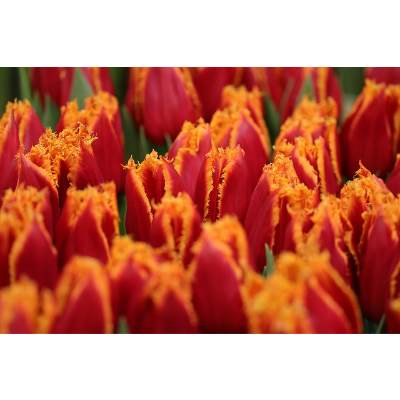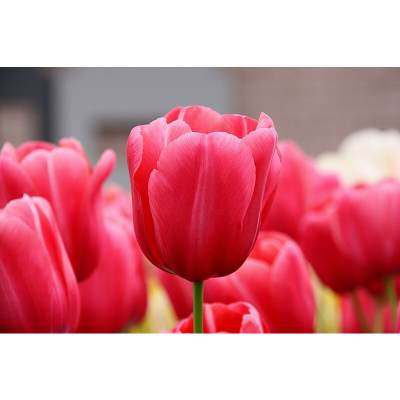Tulip flowers are a delightful addition to any garden, known for their vibrant colors and elegant shapes. In this comprehensive guide, we will explore the key moments of planting, growing, and caring for tulip flowers. Whether you’re a seasoned gardener or just starting out, these insights will help you achieve a stunning display of tulip blooms.
Planting Tulip Bulbs
Planting tulip bulbs is the first step in the journey of growing these beautiful flowers. Here’s how to plant and grow tulip flowers successfully:
Choosing the Right Time to Plant Tulips
The key moment to plant tulip bulbs is in the fall, usually from September to December, before the ground freezes. In warmer climates, planting can be delayed to late December or even January. To ensure a spectacular display of tulip blooms in spring, it’s crucial to plant at the right time.
Selecting the Ideal Location
When choosing a location for your tulips, consider the key moments of sunlight and soil conditions. Tulips thrive in full sun in northern regions but prefer partial shade in the south. Ensure the chosen spot receives the appropriate amount of sunlight for your specific climate.
Preparing the Soil
The key to successfully growing tulip flowers is well-drained soil with a pH level between 6 and 7. If your soil is sandy or heavy clay, consider adding compost to improve its texture and drainage. Well-prepared soil sets the stage for healthy tulip growth.
Planting Depth and Spacing
Planting tulip bulbs at the correct depth is a key moment for their development. Follow the rule of planting bulbs three times as deep as the bulb’s length. Traditionally, tulips are planted 6-8 inches deep. Some gardeners prefer a depth of 12 inches to protect against frost and rodents. Additionally, spacing bulbs 4-6 inches apart provides adequate room for growth.
Watering in Tulip Bulbs
Once you’ve planted your tulip bulbs, it’s essential to water them in thoroughly. This key moment signals to the bulb that it’s time to start growing. However, avoid overwatering, as excess moisture can lead to bulb rot. A moderate watering is usually sufficient to initiate growth.
Special Considerations
In regions with hot, dry springs, additional watering may be required to prolong flowering. Be cautious with irrigation systems, as they can be detrimental to tulips. Proper watering at the right moments ensures the bulbs receive the moisture they need without risking rot.

Also Read : Are Tulips Annual or Perennial?
How to Care for Tulips
Taking care of your tulips throughout their growth cycle is crucial for vibrant blooms. Here’s how to care for tulip flowers effectively:
The Key Role of Sunlight
Tulips require the right amount of sunlight at key moments of their growth. In northern regions, they thrive in full sun, while partial shade is suitable for southern regions. Ensuring they receive the proper light is essential for healthy foliage and vibrant blooms.
Soil Quality and pH
Maintaining well-drained soil with a pH level between 6 and 7 is a key aspect of tulip care. If needed, amend your soil with compost to improve its texture and drainage. Healthy soil provides essential nutrients for tulip growth.
Watering Guidelines
Balanced and timely watering is another key moment in tulip care. While tulips enjoy water, it’s essential not to overwater, as this can lead to bulb rot. Typically, normal rainfall should suffice, but monitor soil moisture during dry spells.
Temperature and Humidity
Tulips thrive in regions with cool winters and mild summers. Extreme heat can cause them to wither quickly, so providing shade or mulch during key moments of hot weather is beneficial. Additionally, maintaining good air circulation helps prevent fungal diseases that thrive in high humidity.
Fertilization
To ensure robust growth and vibrant blooms, fertilize tulip bulbs at planting time in the fall and again in early spring when sprouts emerge. Using a balanced, organic bulb fertilizer provides the necessary nutrients for optimal growth.

Tulip Color Symbolism
Famous for their breathtaking and varied array of hues, tulips have cultural and symbolic meanings of their own. This is a thorough examination of the many hues of tulips:
White Tulips: White tulips are a sign of innocence, purity, and new life. Religious occasions, such as marriages and christenings, often choose them. Tulipa ‘Pim Fortuyn’ and Tulipa ‘Snow Crystal,’ among other white tulips, have a crisp, sophisticated appearance.
Pink Tulips: Especially among friends and family, pink tulips are a symbol of love and compassion. They make lovely presents to wish someone luck on a new adventure or to provide solace through trying times. Tulipa ‘Pink Diamond’ and ‘Angelique’ are two varieties that have soft pink tones.
Red tulips: Red tulips are a representation of ardent devotion and love. Their historical roots are in the tragic love tale of Farhad and Shirin, as well as in Central Asian folklore. For Valentine’s Day, red tulips, such as Tulipa ‘Red Emperor,’ are a fantastic choice since they convey eternal love.
Purple Tulips: Often mistaken for blue or black tulips, true purple tulips are uncommon in the wild. Given their associations with grandeur, wealth, and power, they are appropriate for commemorating important life milestones and fresh starts. Tulipa ‘Ballade’ and ‘Negrita’ are two examples of varieties with eye-catching hues.
Orange Tulips: The histories of the Netherlands and Canada are particularly associated with orange tulips. The Dutch Royal family sent orange tulip bulbs to Canada after World War II as a message of compassion and gratitude. Canadian memorial gardens also employ these colorful flowers as a tribute to their dead loved ones.

Yellow Tulips: Yellow tulips are a symbol of joy, friendship, and fresh beginnings. They’re a great option for thanking someone, marking special occasions, or brightening someone’s mood. Tulipa ‘Secret Perfume’ and ‘Sun Gold’ are two varieties that provide a variety of hues.
Black Tulips: Although deep purple variations are often called black tulips, actual black tulips do not occur naturally. Their association with riches, power, and strength stems from “The Black Tulip,” a book by Alexander Dumas. Tulipa “Paul Scherer” and Tulipa “Queen of Night” are two notable instances.
Green Tulips: Although there are no green tulips, there are Viridiflora tulips with green streaks on their petals, such Tulipa ‘Spring Green.’ Green flowers don’t have a unique meaning, although they often stand for luck, health, and youth.
True blue tulips do not grow naturally, hence blue tulips remain a mystery to gardeners. Tulipa ‘Blue Parrot’ and Tulipa ‘Victoria’s Secret’ are examples of purple tulips with blue overtones that fall under the category of “blue tulips.” Usually, blue flowers stand for harmony and memory.
Bi-Color Tulips: The Tulip Breaking Virus (TBV) produces tulips that are bi-colored in a variety of ways, exhibiting symmetrical tones or distinctive feathery patterning. The Semper Augustus was a well-known broken bi-color tulip with white petals and silky crimson flames. Its ageless appeal made it very valuable during the European tulip mania. In order to preserve their distinctive patterns, collectors store damaged tulips apart from good harvests.
Also Read about the cream tulip meaning.
Fun Facts About Tulips
There are many different types of tulips, which are wonderful flowers with a fascinating history. Did you know that tulips come in more than 3,000 varieties? Contrary to popular belief, these vivid blooms are not indigenous to the Netherlands; rather, they came from Asia. But they arrived in the Netherlands in the sixteenth century, and from then on they were closely linked to Dutch culture.
Members of the lily family, tulips are known for their exquisite beauty on a global scale. The Netherlands produces an astounding 2.5 billion tulip bulbs a year, making it the core of the tulip bulb industry due to the huge demand for the bulbs.
The edible nature of tulip petals is an intriguing feature about them. People often resorted to eating sugar beets and tulips during the 1944 Dutch famine in order to live. It’s evidence of how adaptable these gorgeous blossoms are.
For those curious about the name’s etymology, “tulip” refers to the flower’s turban-like form. Furthermore, the Persian word “dulband,” which means “turban,” is the source of the genus name “Tulipsa.” That means you are virtually staring at a flowery turban when you admire a tulip.
Delve into the colorful world of tulips with our collection of 10 amazing fun facts about tulips and discover the lesser-known facts about this beloved bloom.

Types of Tulips
There are an astounding 3,000 recognized tulip types, so gardeners have a wide range of choices. Here, we’ve outlined the characteristics of 21 categories to assist you in selecting the best kind for your garden:
- Apricot Beauty (Tulipsa ‘Apricot Beauty’): True to their name, these gorgeous pink-orange tulips are magnificent. They may grow up to 24 inches tall and bloom in late April or early May. Either full sun or some shade is ideal for them.
- Tulipa bleu aimable, or Bleu Aimable: These unusual blue tulips, a heritage type that dates back to 1910, may reach a height of 22 inches and bloom in late April. Although they can handle little shade, they prefer full sun, particularly in warm areas.
- Darwin Hybrid (Tulipsa marit): These tulips are ideal for cut bouquets because of their enormous flowers in hues ranging from reddish-orange to scarlet and their long stems. They usually grow to a height of 20 to 24 inches and like full or somewhat shaded environments.
- Double Ice Cream (Tulipsa double late ‘Ice cream’): These flowers are not edible, but they look like scoops of vanilla ice cream in late spring. Their ideal growing conditions are full sun with some shade, and they reach a height of 10 to 16 inches.
- Double Sun Lover (Tulipa ‘Sunlover’): These double-flowering tulips liven up gardens with their rich petals that mimic the hues of a sunset. They thrive in early sun and afternoon shade, often reaching a height of 16 to 18 inches.
- Fosteriana (Tulipa fosteriana): Often called “Emperor” tulips, these early bloomers with enormous flowers that may reach up to 8 inches in diameter. They need at least six hours of strong sunshine to grow to a height of around 10 inches.
- Fringed (Tulipa mascotte): Often referred to as crispa tulips, these colorful, varicolored tulips are famed for their frothy look. These tulips like full sun or light shade, and they usually grow to be 14–18 inches tall.
- Tulipa ‘Grand Perfection’: These tulips have a creamy golden color that turns into pure white with crimson flames as they age. They grow to a height of 15 to 18 inches, bloom in the middle of spring, and do well in both full and partial shade.
- Greigii (Tulipa greigii): These tulips are perfect for rock gardens or pots because of their large, vibrant bowl-shaped blooms and maroon-streaked foliage. They bloom in early to mid-spring and range in height from 9 to 20 inches.
- Kaufmanniana (Tulipa kaufmanniana): These water lily tulips have huge flowers and grow 4–8 inches tall. They are among the earliest tulips to bloom in late March or early April.

Pruning Method for Tulips
Pruning is an essential part of tulip care, ensuring the health and beauty of your plants. Here’s how to approach pruning effectively:
- After your tulips bloom, remove the spent flowers at the key moment to prevent seed formation. This directs the plant’s energy back into the bulb for the next season.
- Allow the stems and leaves to wither and turn yellow or brown naturally. This process ensures that the bulb stores enough nutrients for future growth.
- Only remove the foliage when it’s completely yellow or brown, as removing it prematurely can hinder the bulb’s ability to bloom the following year.
Pruning is a key part of maintaining the overall health of your tulips and promoting their long-term growth.
Propagating Tulips
Propagating tulips allows you to expand your tulip collection without buying new bulbs. Here’s how to propagate tulips effectively:
- Tulips can be divided every 3-5 years when they are dormant in the fall. This process involves carefully separating offsets from the mother bulb.
- Offsets are small bulbs that take a few years to reach maturity. They produce exact copies of the parent plant.
- Propagating tulips through offsets is an economical way to expand your garden and share your tulip love with others.

How to Grow Tulips From Seed
While most gardeners grow tulips from bulbs, you can also grow them from seeds. Here’s how to grow tulips from seed:
- Plant a separate plot of tulips specifically for seed collection. Tulips readily produce seeds that can result in exciting surprises.
- Wait until the seed pods have fully developed and turned brown before collecting the seeds.
- Sow the seeds in a well-prepared garden bed and provide them with the necessary care throughout their growth.
Growing tulips from seed allows you to explore the fascinating world of tulip genetics and create unique varieties.
Potting and Repotting Tulips
Potting tulips allows you to enjoy their beauty indoors. Here’s how to pot and repot tulips effectively:
- Select a suitable container with drainage holes and fill it with well-draining potting mix.
- Plant the tulip bulbs at the appropriate depth and spacing, similar to outdoor planting.
- Water the pot thoroughly after planting, ensuring the soil is evenly moist.
- Place the pot in a cool, dark location for several weeks to simulate winter conditions.
- Once shoots appear, move the pot to a well-lit area, and watch your tulips bloom indoors.
Potting tulips adds a burst of color to your indoor space during the gloomy winter months.

Overwintering Tulips
In areas with harsh winters, overwintering tulips is essential to protect the bulbs and ensure their return in full bloom. Here’s how to overwinter tulips:
- Cover the bulb bed with 2-3 inches of mulch after planting to provide insulation against extreme cold.
- Alternatively, you can lift the bulbs out of the ground, clean them, and store them in a cool, dry place.
- Proper overwintering ensures your tulips return in full bloom next spring.
Common Pests and Plant Diseases

Like many other plants, tulips are vulnerable to a variety of pests and illnesses that may harm their vitality and general health. Bacterial soft rot, Botrytis blight (gray mold), bulb, root, and stem rot, and viral diseases like Tulip breaking virus are a few of the many problems tulips might encounter. The fungal infection Botrytis tulipae, however, is the source of “Tulip fire,” one of the most serious illnesses that damage tulips.
Brown patches appear on the leaves of tulip plants during tulip fires, and these spots ultimately cause the leaves to sag and wither. If left untreated, this disease may spread quickly and negatively impact tulip populations.
It is possible to stop the Tulip fire before it starts and spreads. Using tulip bulbs to practice crop rotation—ideally, changing them every three years—is one successful tactic. By lowering the amount of fungus spores that accumulate in the soil, this aids in ending the disease cycle. Further limiting the disease’s spread is the removal of flower heads before they show symptoms.
Tulips may develop and look differently due to a variety of viruses, in addition to fungal diseases like Tulip fire. Stunted development, twisted plant growth, mottled leaves, and streaked blooms are some of the symptoms of these viral diseases.
The existence of pests is another issue with tulips. Although illnesses have received much of the attention in this context, pests such as Fusarium oxysporum may also be dangerous. Brown patches on tulip roots are a common symptom of Fusarium oxysporum, which may also cause pink or white fungus to form on the bulbs. Another problem that tulips might have is basal rot, which shows up as pink or white fungus on the bulbs or as dark brown spots. The fungi infections have the potential to impair the plants and impact their general well-being.
Botrytis Blight
Botrytis blight causes twisted and withered foliage. Inspect bulbs when purchasing to avoid infected ones.
Bacterial Soft Rot
Heat-treat bulbs in 120°F water for 2 minutes to kill bulb mites, which cause bacterial soft rot.
Gray Bulb Rot
Gray bulb rot is a fungal disease. Inspect bulbs for decay when buying and remove infected ones.
Pythium Root Rot
Ensure good air circulation to reduce the risk of pythium root rot, another fungal disease.
Stem and Bulb Nematode
Plant bulbs 12 inches deep to deter rodents, which can transmit stem and bulb nematodes.
Tulip-Breaking Virus
Avoid aphids and thrips to prevent the tulip-breaking virus.
Basal Rot
Proper soil drainage helps prevent basal rot, which affects the bulb’s base.
Understanding these common problems and their solutions will help you keep your tulips healthy and vibrant.
How to Get Tulips to Bloom
Tulips are known for their stunning blooms, and you can encourage more flowers with the following tips:
Bloom Months
Tulips typically bloom between March and May, depending on the variety.
How Long Do Tulips Bloom?
Tulips generally bloom for 1-3 weeks, depending on environmental factors.
Failure to Bloom
If your tulips fail to bloom, they may have been stressed or lacked proper chilling.
What Do Tulip Flowers Look and Smell Like?
Tulip flowers come in various shapes and sizes, from classic to fringed and parrot tulips. They have a mild, pleasant fragrance.
How to Encourage More Blooms
To encourage more blooms, choose early, mid, and late-blooming varieties, ensuring a continuous display of color.
Deadheading Tulip Flowers
Remove spent blooms to divert energy back to the bulb for the next season.
Caring for Tulips After They Bloom
After blooming, let the foliage turn yellow before removing it for a cleaner look.
By following these guidelines, you can ensure your tulips bloom beautifully year after year.
Common Problems With Tulips
Tulips may face various issues, but understanding them can help you address and prevent problems:
Botrytis Blight
Botrytis blight causes twisted, withered foliage and brown spots on flowers. Remove affected parts and improve air circulation.
Bacterial Soft Rot
To prevent bacterial soft rot, heat-treat bulbs in hot water and choose healthy bulbs when planting.
Gray Bulb Rot
Gray bulb rot is a fungal disease. Inspect bulbs when purchasing and remove any showing signs of decay.
Pythium Root Rot
Ensure good air circulation to reduce the risk of pythium root rot.
Stem and Bulb Nematode
Plant bulbs deep to deter rodents, which can transmit stem and bulb nematodes.
Tulip-Breaking Virus
Prevent aphids and thrips to avoid the tulip-breaking virus.
Basal Rot
Proper soil drainage helps prevent basal rot, which affects the bulb’s base.
By being vigilant and taking proactive measures, you can keep your tulips healthy and thriving.
Final Thoughts
Tulips are a symbol of beauty and grace, and with proper care, they can adorn your garden or home with their stunning blooms. Whether you’re a seasoned gardener or just starting, these tips and insights will help you plant, grow, and care for tulip flowers, ensuring a colorful and vibrant display year after year. Enjoy the beauty of tulips and the joy they bring to your life and surroundings.
